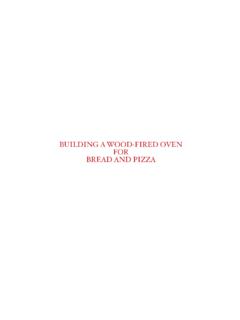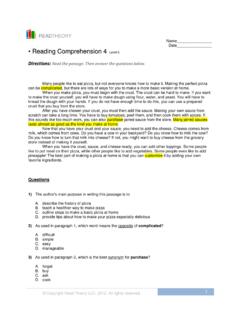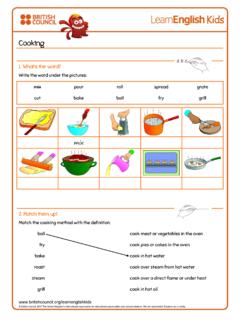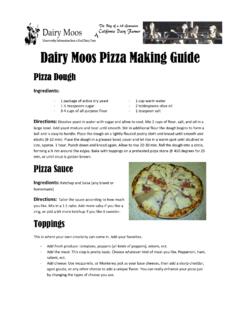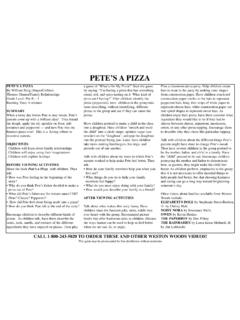Transcription of How to build a Pizza Oven in 4 days - Pinkbird
1 How to build a Pizza Oven in 4 days Preparation day (slab) 1. Foundation 1500 deep x 1300 wide x 75mm deep Required 20 bags cement pre mix. If you already have a concrete base, you save this prep DAY 1 preparing the base2. Besser brick (400x200) base 3 deep, 3 wide, 5 high. Total 47 bricks. 3. Check bricks are level. Use plumb line to ensure walls are vertical. 4. Insert steel angle for shelf. Drop this between bricks set into mortar 5. Second row of angle for base of oven to rest on 6. Galvanised lintel to hold front row of besser bricks. Steel angle facing upwards behind 7 2nd steel angle facing downwards to support base of oven 8. Helper still in PJ 9 10.
2 Besser brick base complete 11. Could fill the besser bricks with concrete which prevents movement and reduces cracks in the mortar so I have been told. Also could put reinforcement bar inside the bricks. I didn t. Mine s still standing 12 13. Fill besser brick holes with scraps of brick and concrete, stuff with paper, fill top with concrete. (see #11 could fill them with concrete from the bottom and ) 14. Timber formwork pieces supported under front besser bricks to hold concrete in place. 15. Ready for next stage. That s the end of day #1 Sand leveling photo required here DAY 2 The oven floor 16. Drop in 15mm cement sheet 17. Fill with crushed rock and packed down hard.
3 18. Level sand with straight timber or pipe. Place timber runners each side of sand area to create perfectly smooth sand, packed down hard with trowel. 19. brickies sand on top of crushed rock. This would be better if it was sand mixed with cement as I have had a little bit of movement in the sand. 20. Square off sand edges around inside brick pavers. 21. Set pavers in brick pattern, to offset the joins. Make the centre row of pavers a little wider to create oval shaped oven wider in the centre. 22. Trowel cement mortar to the outside edge of the pavers to secure them in place. This standard mortar isn t stable in high heat so just use it around the outside of the pavers (not under them) 23.
4 I extended the front pavers 20mm over the edge of the base (right hand side of above photo). This isn t really necessary you can use any sort of paver or tile on the outside edge of the oven as they don t get hot. 24. Form the arch. I used a light smear of ceramic cement to hold the arch pavers in place. A strong bond isn t necessary because the arch is held in place by the main oven structure later. 25. Arch supported by bricks. Arch stuck together with heat resistant ceramic cement. The theory is the door & flue opening height should be 63% of the height of the oven, so warm air is captured inside the top of the oven. 25. After arch complete, place base pavers in shape of oven.
5 Stick together and down with ceramic cement. 26. Cut outside pavers (refractory pavers not necessary for the outside but I used them) and mortar these in place. They don t get too hot. 27. Brickwork done, end of day 2. Arch dimensions 30cm high X 46cm wide Floor & dome dimensions depth (1m deep + archway brick 24cm) X 88cm wide X 48cm high DAY 3 Shaping the dome28. Stack polystyrene fruit boxes into the oven (this just saves on sand and makes it easier to empty the sand out afterwards). 29. Place a post in the middle to set the height (48cm) and provide strength to hold the concrete. Plate on top not necessary. 30. Cover the styrene boxes with sand 31. Pack the sand down firmly and form the shape with a brickies trowel.
6 32. Keep the edges of the brickwork clean to provide a good surface for the concrete to stick to. Bring sand close to the inside edges of the bricks to avoid edges in the finished dome. 33. The concrete dome face should be flush with the inside edge of the pavers forming the bottom edge of the dome wall 34. Form the flue cavity. The theory is that the flue opening should be 63% of the height of the dome, that would be the bottom of the dip here above between the dome and the flue opening. So that dip is 30cm off the pavers, the top of the dome is 48cm off the pavers. The arch is also 30cm. 35. This flue opening is not big enough I d make it a 15cm/6 diameter flue (this one is only 11cm/4 ) 36.
7 Form a cardboard tube slightly larger than the stainless steel flue, so the flue will slideinto the concrete dome snugly 37. Finished sand oven dome. This shape has worked very well after using the oven for a year. I wouldn t change it. 38. Cover dome in wet newspaper I used plastic but I reckon wet newspaper would do the job better. Make sure you leave bricks uncovered so concrete can stick to them. 39. Mix up the refractory cement mix in a wheel barrow, a bag or two at a time (I used 9 bags in total). 40. Wearing rubber gloves (not necessarily pink ones) make concrete patties. 41. Pack them onto the dome. I started at the top and worked around and down.
8 42. Cover the whole sand dome do all this in one session so the concrete doesn t set before you finish the dome. 43. You can add stainless steel strands after the first layer of concrete for reinforcing, but I now this this it totally unnecessary. 44. Put the ceramic pipeinto the dome so it sticks into the sand by 20mm and faces forward so you can easily see the thermometer while cooking. Use a dowel to make a hole if you don t have a pipe. That d do just as well. It should be about 2/3 up the wall of the oven inside. Start second layer of concrete patties. 45. The concrete layers needs to be about 50mm thick. Using 2 layers of concrete patties. Make sure brick pavers forming the base of the wall are covered.
9 46. Pack concrete firmly around the arch to provide strength to support it. 47. Form a flat area around the flue cavity. As you can see, I m working into the night so technically not completing within the day 48. Remove the cardboard tube to reveal the clear hole into what will be the oven cavity. 49. Note the flue cavity is slightly over the archway brickwork. This is to stop the stainless steel flue from sliding into the oven should it become loose for any reason (it hasn t by the ) 50. Damper Mould Cover a piece of plywood (which is 3mm larger than the damper slide) with baking paper (so it ll slip out easily). 51. Place the plywood so it covers the flue void.
10 Note I trimmer the corners off the plywood before I set it (see next pic) 52. Stick the cardboard tube to the plywood. Cut a groove into the bottom of the cardboard tube and slide a piece of cement sheet into the tube (to stop the stainless steel flue from hitting the damper slide) 53. cement around the flue, the cement sheet support shelf and over the top of the damper slide mould. 54. Cover the whole dome in a third layer of concrete patties, strengthening the area around the flue and damper slide. 55. Day was a long actualy this is the next DAY 4 56. Get your daughter to clean the sand out of the oven. 57. Remove cardboard tube and insert stainless steel flu.
